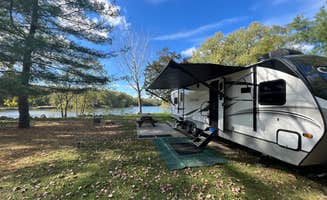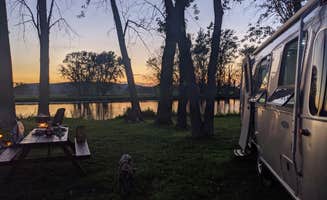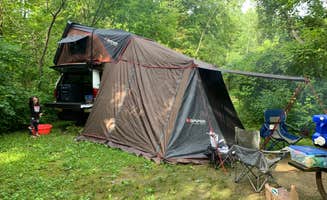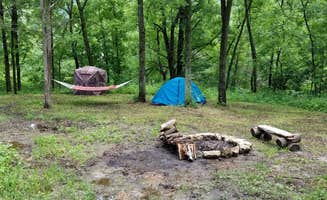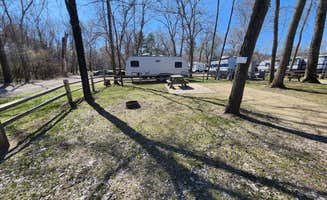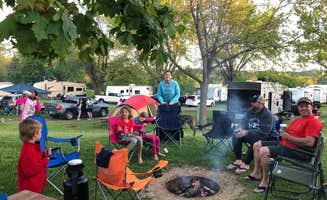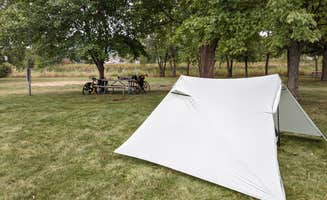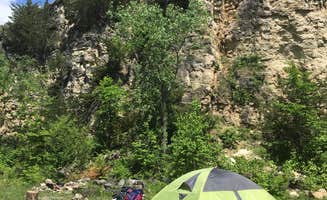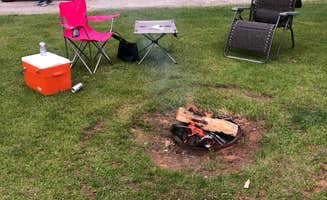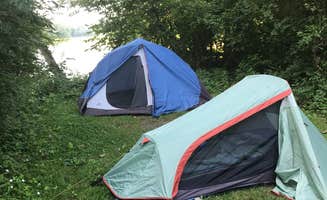Beaver Creek Valley State Park, located southwest of La Crescent, Minnesota, offers campsites nestled in a valley surrounded by hardwood forest with elevation changes of 250-400 feet throughout the park. The rushing creek creates background noise at many campsites, providing natural sound insulation. Camping season typically runs April through November, with sites often requiring advance reservations during summer weekends.
What to do
Fishing opportunities year-round: Goose Island provides excellent water access for fishing enthusiasts. "This campground is right on the waters of the Mississippi. There are several locations to launch boats, canoes, & kayaks," notes one visitor. The backwaters of the Mississippi create protected areas for different fish species.
Hiking trail exploration: Great River Bluffs State Park Campground offers several overlook trails with minimal difficulty. "The trail system is very well labeled with maps along each trail. The trail system is mostly level and I would label as easy hiking with rolling hills. The park contains two viewing areas King's and Queen's Bluff," explains a camper. Most trails can be completed in under 2.5 hours.
Bicycle access to regional trails: Camping near La Crescent provides connections to the Root River State Bike Trail and Great River Trail. A visitor to Veterans Memorial Park & Campground explains, "Vet's Park has direct access to the La Crosse Great River Trail where you can connect onto Elroy/Sparta Trail to the east and directly to La Crosse Great River Trail to the northwest." Many campgrounds offer bike rentals or are located near trailheads.
What campers like
Shaded camping spots: Forest cover at many La Crescent area campgrounds provides natural temperature regulation. At Beaver Creek Valley State Park Campground, campers enjoy dense tree coverage. "We've camped at Beaver Creek quite a few times. Some sites are bigger than others, but they're all grassy and private which is nice," says a regular visitor. These shaded sites can be 5-10 degrees cooler than exposed areas.
Water features beyond the Mississippi: While the Mississippi dominates the landscape, smaller waterways offer unique experiences. "The creek that runs through is beautiful, cold, and clear. I didn't have any luck fishing though I could see the trout hanging out in an easily accessible pool at the end of a run," notes one Beaver Creek Valley camper. Natural springs and smaller tributary creeks provide alternatives to the main river.
Accessible nature observation: Bird and wildlife watching opportunities abound in the region. One camper suggests: "Bring binoculars; the river valley is a great viewing area for waterfowl, eagles, and hawks." Spring and fall migrations bring seasonal species through the Mississippi Flyway, with peak activity in April-May and September-October.
What you should know
Flooding impacts on campgrounds: Low-lying sites near the Mississippi experience regular flooding. A camper at Pettibone Resort reports, "We got flooded out the only day we stayed. Got our money back for second night. Thank you. Mississippi was over flowing this flood plain and yet still beautiful." Spring camping carries higher flood risk, particularly April-May.
Insect preparation essential: Mosquitoes and ticks are prevalent, especially in wooded and riverside sites. "The bugs and mosquitos were almost unbearable. We fogged the site daily, had thermacells, and coated ourselves in bug spray - still came home completely bit up," warns a visitor to Perrot State Park. Bring permethrin-treated clothing and multiple repellent options.
No-cell-service zones: Several campgrounds have limited or no connectivity. A camper at Beaver Creek Valley notes: "The only thing to know is there is no cell reception because of the valley. This is great if you want to get away from it all, but if you're staying a while and need to work, this isn't the place to do it." Valley locations typically have the poorest service, with blufftop sites offering better connectivity.
Tips for camping with families
Natural playgrounds and kid-friendly spaces: Houston Nature Center offers dedicated natural play areas. "Trail Head Park has a 1 acre natural playground near the campsite. The playground has a zip line, tree house, small rock wall, and more," explains a visitor. These facilities provide entertainment without electronic devices.
Educational opportunities: Many campgrounds incorporate nature learning. "Inside the Nature Center, they have interactive and interesting displays. The highlight of this campground is the Root River State Bike Trail and the Owl Center in the town of Houston," shares a camper. Programs often run weekends between Memorial Day and Labor Day.
Kid-friendly water access: When camping with children, look for gradual water entry points. "The lake is about 600 acres in size and about 11 feet deep at the deepest point," explains a visitor to Lake Neshonoc. Swimming areas with designated boundaries provide safer experiences for younger campers.
Tips from RVers
Seasonal considerations for RV camping: Many campgrounds near La Crescent have limited seasonal availability. Pettibone Resort operates from "April 15 to October 15," requiring advance planning for shoulder season visits. Water systems are typically winterized by mid-October and not reopened until late April.
Site levelness varies significantly: RVers should prepare for adjustment needs. A camper at Neshonoc Lakeside reports, "It was spacious and very well kept, with a great view of the lake. Very easy to back in and get set up, almost level and took very little adjustment to get our spot in order." Bringing leveling blocks is recommended for most area campgrounds.
Electric hookup availability: For those requiring electrical connections, availability varies by campground. "All sites has a gravel pad with a grass yard, fire ring, and picnic table. The fire rings are sunk completely into the ground for some reason," notes an RV camper at Neshonoc Lakeside. Amperage varies from 20-50 amp depending on the campground and site section.


